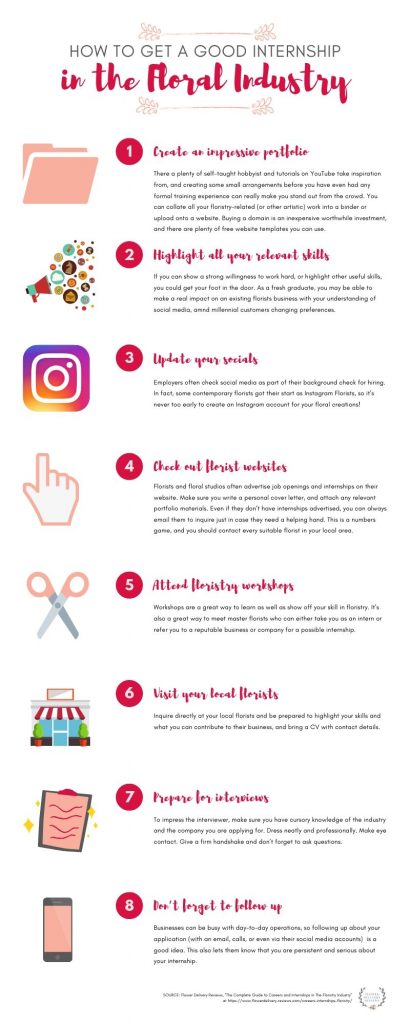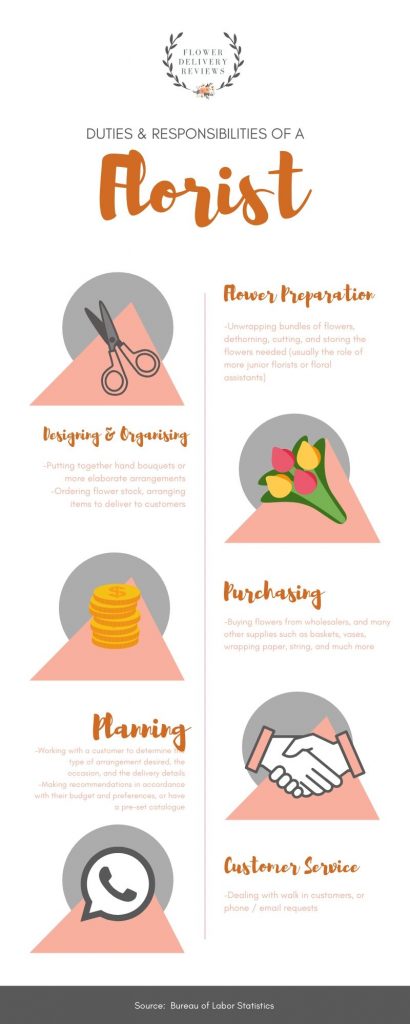The 8 Easy Steps to Becoming a Florist
Flowers bring a lot of beauty and joy into the world. You can make someone smile just by giving them a bouquet of flowers. Florists make this gift of happiness possible using their expertise in crafting beautiful flower arrangements. In 2016, the US Census reported over 50,000 florists employed in more than 10,000 establishments. Meanwhile, a florist’s median pay per year is pegged at $27,200 or $13.08 per hour by the Bureau of Labor Statistics as of 2018. So, if you want to become part of this billion-dollar industry, we have distilled the process of becoming a florist into 8 easy steps!
STEP 1: Get Basic Education
STEP 2: Know Your Stuff AKA Get Formal Training
STEP 3: Get a Good Internship
STEP 4: Upgrade Your Skills and Get Certified!
STEP 5: Know How to Market Yourself
STEP 6: Apply for Jobs or Become a Freelance Florist
STEP 7: Join Professional Associations
STEP 8: Set Up Your Own Business
Note: Due to the rising cases of COVID-19 and lockdown accross many states in America, most non-essential industries, including the flower industry, are instructed to shut down to help curb the spread of the virus. Most of these floristry schools are expected to reopen once the lockdown measures have been ease down, albeit an exact date remains unclear.
1. Get Basic Education

A minimum requirement in becoming a florist is a high school diploma or the equivalent. So, you need to graduate high school. Your education until high school will be your foundation before moving on to your specialisation which is floristry.
2. Know Your Stuff AKA Get Formal Training

After graduating high school and getting general education, it’s time to focus on floristry. There are floristry programs and courses in private floral schools, vocational schools and community colleges which can give you valuable lessons about identifying plants and flowers, cultivating and taking care of flowers, the fundamentals of flower arrangements, as well as marketing and business courses which would be helpful if you plan to start your own business.
The skills required to become a florist may vary depending on the type of shop or establishment (e.g. supermarket or online florist). In general, these are duties and responsibilities of a typical florist:
To get formal training, you can either go for a certification or an Associate’s degree. Here are Degree and Certificate Programs in Floriculture, Horticulture and Floral Design compiled by the Society of American Florists:
Another, more informal route, to learning the basic skills of a florist is to become an apprentice to a floral designer and get hands-on experience while also learning along the way. After that, you can decide to enrol in a program to get your credentials or get certified.
3. Get a Good Internship
After educating yourself, it’s time to apply your skills in a real-world setting. Ideally, the process begins by getting formal training then becoming an intern, but steps 2 & 3 are usually interchanged. That is to say, there are people who learn floristry from a mentor then decide to pursue the job professionally, so they subsequently get formal training or get certifications. Either way, both steps are necessary in establishing yourself as a professional florist.
An internship is an important step in honing your skills and applying what you’ve learned in the real-world setting. Here you get to experience the nitty gritty of the job, especially in working with different types of customers, suppliers and the stress of working during peak season.
If you are enrolled in a college or vocational school, they can usually help you out in searching for a good internship or you can do your own research by looking at the website of different companies, shops and institutions and submitting your CV to their official email. You can also send your CV to local florists and flower shops. The best thing is if you already have a master florist or establishment in mind, then you can just check out their website to find out where you can get in contact with the person in charge of internships.
Here are some tips and tricks to hustle your way into the industry:

Click to view full size
4. Upgrade Your Skills and Get Certified!
This step is necessary to step up your game as well as part of improving yourself professionally. It also gives you more prestige and credibility, especially when pitching to big clients and corporations.
The American Institute of Floral Designers (AIFD) provides certification and accreditation for floral designers. You also become a member of the AIFD once you become a Certified Floral Designer. As a member, you can take online courses at AIFD and participate in hands-on workshops to improve your skills and stay updated with industry trends.
While becoming a Certified Floral Designer (CFD) is purely voluntary, this is a good way to boost your reputation as well as a good way to network. There are three ways to become Certified Floral Designer:
- Attend and complete the appropriate floral design coursework at an AIFD® Education Partner, approved State Floral Association or SAIFD Chapter and then pass the PFDE online test.
- Participate in the Professional Floral Design Evaluation (PFDE) which is held once annually, then pass the online test and hands-on design evaluation.
- Participate and earn an average score of 7.0 for all designs with no design lower than a 6.5 in the SAIFD Student Competition at Symposium. Qualified participants can be recommended for CFD to AIFD. They will have to then pass the online test with an 80% or higher and pay the necessary fees.
Once you accomplish any of the three options, you will be awarded with the CFD designation, including a CFD pin and a CFD certificate, as well as listed in the AIFD online and printed directories. CFDs will have to pay the proper annual fees and continuing education requirements must be maintained to receive these benefits.
Of course, professional growth and certifications do not need to be confined to the floral design field. After you finish an internship, you’ll usually find out the areas which need more improvement. Maybe you need to upgrade your marketing skills or learn more about contemporary floral designs, perhaps an accounting course would help. This is your chance to cover all the bases and ensure success in your career path.
5. Know How to Market Yourself
After finishing basic education, learning the fundamentals of floristry and floriculture, getting your hands dirty with a good internship, and then boosting your credentials with a voluntary certification, it’s time to market yourself.
First and foremost, keep your CV and portfolio updated. It’s easier to keep track of your accomplishments and let others know about it by keeping an updated portfolio which you can upload online and regularly update.
Second, maintain an active social media presence on all relevant platforms. Some contemporary florists actually began as Instagram florists because the platform allows them to show off their designs where interested customers and prospective clients and quickly and easily contact you. Remember to stay professional with your messaging as this can also serve as your portfolio, since head-hunters typically check socials when hiring.
Third, utilize word-of-mouth by activating your social groups. Perhaps you can give your friends tokens on their special occasions and encourage them to post it on their socials, so more people can discover your services. Sending free floral arrangements to influencers is another way to spread the word about you. Visual platforms like Instagram, Pinterest, Youtube and Facebook have more mileage when it comes to selling your products.
Finally, don’t forget LinkedIn. While this is not a creative and visual platform, it is a good place for forging professional partnerships. This is especially useful for corporate partnerships and deals. For example, you can pitch floral subscription to businesses and corporate flowers for events, etc.
6. Apply for Jobs or Become a Freelance Florist
Once you have built a solid foundation, then it’s time to practice your craft and earn! The steps to take when applying for a job is basically the same as finding a good internship, although the competition will be steeper. While shops, companies and institutions may take multiple interns at a time, a full-time florist or floral designer is limited to one or two per business, so know how to highlight your skills.
If you want the traditional route of being the master florist of a shop or head floral designer, then go ahead and submit your CV to the companies you are interested in. On the other hand, you can also opt to go freelance and work on a project basis. You can narrow your target and focus on weddings and events. Freelancing requires minimum capital, especially if you work on per client basis. This is a great jump-off point to eventually opening a business of your own because you’ll be dipping your toes on all aspects of operating a floral business.
7. Join Professional Associations
Professional associations like the AIFD and the Society of American Florists (SAF) are great avenues for expanding your network. Membership in prestigious associations is also an added badge to your brand. A good way to be updated about new associations is to subscribe to trade magazine and newsletters. Just remember to choose your memberships wisely. Quality is better than quantity. Make sure you only choose reputable institutions which will add prestige to you and your brand.
8. Set Up Your Own Business
Finally, while not everyone is cut out for entrepreneurship, the goal is often to “be your own boss” (so to speak) by setting up your own business. Not only will you be spreading love, happiness and positivity through beautiful blooms, you can also help create opportunities for others through your brand. This is the ultimate challenge to your skills and creativity. Plus, having your own business opens up the chance to earn more compared to when you are an employee with a fixed income.
Are you ready? Get yourself up to speed about possible careers in floristry and how to set up your own flower shop, read our Complete Guide to Careers and Internships in The Floristry Industry.
ADDITIONAL RESOURCES
American Floral Endowment
> Floriculture Scholarships (PDF)
> Make People Smile: Grow Your Future in the Floral Industry (PDF)
American Institute of Floral Designers
> Certified Floral Designer (CFD) designation program
> AIFD Resource Center
Bureau of Labor Statistics
Indeed: Floral Designer Job
Market News
National FFA Organization
> FFA Career Development (CDE) Awards
Produce Marketing Association
Short Courses Portal
Society of American Florists
> Careers in Floriculture: Catalog of Schools (PDF)
United States International Trade Commission
The USDA Economics, Statistics and Market Information System (ESMIS)











